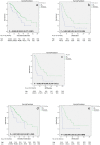Characterisation of male breast cancer: a descriptive biomarker study from a large patient series
- PMID: 28350011
- PMCID: PMC5368596
- DOI: 10.1038/srep45293
Characterisation of male breast cancer: a descriptive biomarker study from a large patient series
Abstract
Male breast cancer (MBC) is rare. We assembled 446 MBCs on tissue microarrays and assessed clinicopathological information, together with data from 15 published studies, totalling 1984 cases. By immunohistochemistry we investigated 14 biomarkers (ERα, ERβ1, ERβ2, ERβ5, PR, AR, Bcl-2, HER2, p53, E-cadherin, Ki67, survivin, prolactin, FOXA1) for survival impact. The main histological subtype in our cohort and combined analyses was ductal (81%, 83%), grade 2; (40%, 44%), respectively. Cases were predominantly ERα (84%, 82%) and PR positive (74%, 71%), respectively, with HER2 expression being infrequent (2%, 10%), respectively. In our cohort, advanced age (>67) was the strongest predictor of overall (OS) and disease free survival (DFS) (p = 0.00001; p = 0.01, respectively). Node positivity negatively impacted DFS (p = 0.04). FOXA1 p = 0.005) and AR p = 0.009) were both positively prognostic for DFS, remaining upon multivariate analysis. Network analysis showed ERα, AR and FOXA1 significantly correlated. In summary, the principle phenotype of MBC was luminal A, ductal, grade 2. In ERα+ MBC, only AR had prognostic significance, suggesting AR blockade could be employed therapeutically.
Conflict of interest statement
The authors declare no competing financial interests.
Figures


References
-
- Giordano S., Cohen D., Buzdar A., Perkins G. & Hortobagyi G. Breast carcinoma in men: a population-based study. Cancer 101, 51–57 (2004). - PubMed
-
- CRUK. Breast cancer incidence in males. Available: http://www.cancerresearchuk.org/health-professional/cancer-statistics/st... Accessed: 18 Aug 2016 (2014).
-
- American Cancer Society: Cancer Facts and Figures 2014. Atlanta, Ga: Avaliable from: http://www.cancer.org/acs/groups/content/@research/documents/webcontent/... Accessed 19 Aug 2016. (American Cancer Society 2014).
Publication types
MeSH terms
Substances
LinkOut - more resources
Full Text Sources
Other Literature Sources
Medical
Research Materials
Miscellaneous

